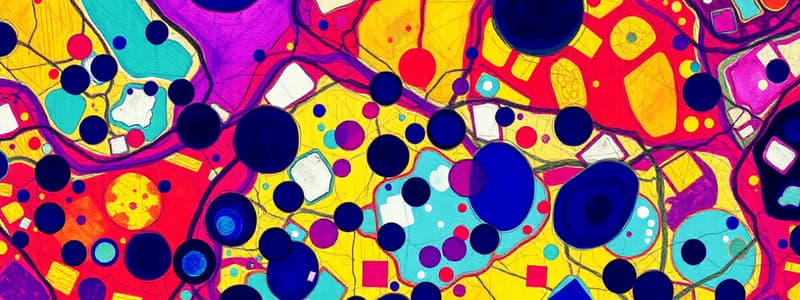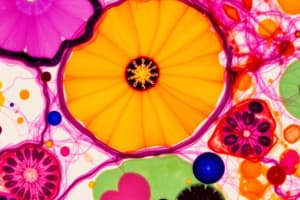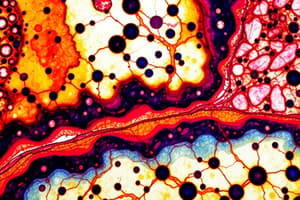Podcast
Questions and Answers
What color does PAS staining produce when it stains carbohydrates?
What color does PAS staining produce when it stains carbohydrates?
- Magenta color (correct)
- Black color
- Blue color
- Red color
What is the resolution power of a light microscope?
What is the resolution power of a light microscope?
- 1 nm
- 0.1 nm
- 500 nm
- 200 nm (correct)
Which type of microscope offers three-dimensional visualization of the surface of a specimen?
Which type of microscope offers three-dimensional visualization of the surface of a specimen?
- Phase Contrast Microscope
- Confocal Microscope
- Transmission Electron Microscope
- Scanning Electron Microscope (correct)
How is the magnification of a light microscope calculated?
How is the magnification of a light microscope calculated?
Which of the following statements about light microscopes and electron microscopes is true?
Which of the following statements about light microscopes and electron microscopes is true?
Flashcards
Light Microscope Magnification
Light Microscope Magnification
Calculated by multiplying the magnification of the objective lens and the ocular lens.
PAS Stain
PAS Stain
A stain used to identify carbohydrates, producing red color.
Resolution Power (LM)
Resolution Power (LM)
The ability of a light microscope to differentiate between two closely spaced points, typically around 0.2 micrometers.
Electron Microscope Types
Electron Microscope Types
Signup and view all the flashcards
Resolution Power (EM)
Resolution Power (EM)
Signup and view all the flashcards
Study Notes
Introduction
- Course topic: Histology
- Instructor: Dr. Dalia Eita
- Location: Mansoura National University
Agenda
- Methods for preparing light microscopic sections
- Principles of staining with Hematoxylin & Eosin
- Types of stains
- Types of microscopes
Learning Objectives
- Demonstrate tissue fixation and embedding procedures
- Demonstrate common staining methods, their rationale, and the usefulness of cytochemical and histochemical techniques
- Differentiate between light and electron microscopes
Special stains for organic components: Carbohydrates
- Periodic acid-Schiff (PAS) stains carbohydrates
- Reacts with carbohydrates to produce free aldehyde groups
- Combined with Schiff's reagent to produce a magenta color
- Best Carmine stains glycogen
- Specific stain for glycogen
- Stains glycogen granules red
Special stains for organic components: Lipids
- Frozen sections are used
- Sudan III stains lipids orange
- Sudan black stains lipids black
- Osmic acid stains lipids black
Other methods of staining
- Vital stains stain living cells (e.g., trypan blue or Indian ink stains phagocytic cells for observing them in living tissue)
- Metachromatic stains stain certain components differently from the dye's color (e.g. granules of mast cells stained reddish purple with toluidine blue)
- Enzyme histochemistry often uses frozen sections to demonstrate enzyme activity (e.g., alkaline phosphatase enzyme in kidney tubules)
Quiz: PAS Stain
- PAS stain for carbohydrates produces a magenta color
Microscopy: Types of Microscopes
- Light microscopes (student microscopes)
- Magnification: 40x, 100x, 400x, 1000x
- Electron microscopes
- Magnification: up to 50,000x
Microscopy: Resolution Power
- Resolution power measures the smallest distance between particles that can be distinguished under the microscope.
- Light microscope resolution power: ~0.2 μm (200 nm)
- Electron microscope resolution power: ~1 nm
- Magnification of light microscope = Magnification of Objective Lens x Magnification of Ocular Lens
Practical Microscopy Class
- Instructions for using a microscope:
- Turn the microscope on
- Place the slide on the stage and secure
- Rotate the low-power objective
- Focus the slide using the coarse adjustment knob
- Switch to medium & high power objectives, adjust using fine adjustment knob only
Micro technique for Electron Microscopy
- Ultrathin sections (50-100 nm): Obtained using an ultramicrotome
- Staining with heavy metals (lead citrate & uranyl acetate)
- Electron micrograph:
- Dark components = electron-dense
- Light components = electron-lucent
Scanning Electron Microscope(SEM)
- Allows 3-dimensional visualization of the surface of a fixed specimen
Studying That Suits You
Use AI to generate personalized quizzes and flashcards to suit your learning preferences.




